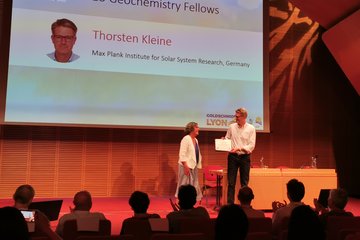Alle Typen
181.
Buch
Magnetic coupling at sun and stars. Elsevier Ltd., Oxford, Orlando and Tokyo (2007), 118 S.
182.
Buch
Space Plasma Simulation. Springer-Verlag, Heidelberg (2003), 351 S.
183.
Buch
Magnetic helicity at the Sun, in solar wind and magnetospheres - vistas from X-Ray Observatories. Elsevier (2003), 2091 S.
184.
Buch
Comparative reconnection studies at the sun and in magnetospheres. Elsevier Science (2002), 133 S.
185.
Buch
Plasma Astrophysics and Space Physics. Kluwer Academic Publishers, Dordrecht (1999), 772 S.
186.
Buchkapitel
Kinetic Simulations of Electron Acceleration at Mercury. In: Magnetic Fields in the Solar System: Planets, Moons and Solar Wind Interactions, S. 201 - 240 (Hg. Lühr, H.; Wicht, J.; Gilder, S. A.; Holschneider, M.). Springer, Cham (2018)
187.
Buchkapitel
Anomalous momentum transport in astrophysical return-current beam plasmas - the two-dimensional electromagnetic case. In: Advances in Plasma Astrophysics, S. 106 - 109 (Hg. Bonnano, A.; de Gouveia dal Pino, E.; Kosovichev, A.). International Astronomical Union (2011)
188.
Buchkapitel
Ab Initio Vlasov Code Simulation of Micro-Turbulence, Phase Space Structure Formation and the Resulting Anomalous Transport and Particle Acceleration in Collisionless Astrophysical Plasmas, I: The 2D2V Code. In: High Performance Computing in Science and Engineering, S. 19 - 28 (Hg. Wagner, S.; Steinmetz, M.; Bode, A.; Brehm, M.). Springer, Berlin-Heidelberg (2008)
189.
Buchkapitel
Vlasov-code simulation. In: Advanced methods for space simulations, S. 23 - 46 (Hg. Usui, H.; Omura, Y.). TERRAPUB, Tokyo (2007)
190.
Buchkapitel
Theory and simulation of reconnection. In: Solar Dynamics and its Effects on the Heliopshere and Earth, S. 345 - 360 (Hg. Baker, D. N.; Klecker, B.; Schwartz, S. J.; Schwenn, R.; von Steiger, R.). Springer, Dordrecht (2007)
191.
Buchkapitel
Investigation of Reconnection in the Solar Corona by Numerical Simulation Based on Solar-B Observations. In: New Solar Physics with Solar-B Mission, S. 407 - 420 (Hg. Shibata, K.; Nagata, S.; Sakurai, T.). Astronomical Society of the Pacific (2007)
192.
Buchkapitel
Role of current-aligned instabilities in reconnection. In: Reconnection of Magnetic Fields: Magnetohydrodynamics, Collisionless Theory and Observations, S. 144 - 153 (Hg. Birn, J.; Priest, E.). Cambridge University Press, Cambridge, UK (2007)
193.
Buchkapitel
Calculations of Photospheric Plasma Velocity Fields using Photospheric Magnetic Field Measurements. In: New Solar Physics with Solar-B Mission, S. 183 - 192 (Hg. Shibata, K.; Nagata, S.; Sakurai, T.). Astronomical Society of the Pacific (2007)
194.
Buchkapitel
Plasma acceleration due to transition region reconnection. In: Particle acceleration in astrophysical plasmas: Geospace and beyond, S. 161 - 170 (Hg. Horwitz, J. L.; Perez, J. D.; Preece, R. D.; Queenby, J.). American Geophysical Union (2005)
195.
Buchkapitel
Space plasma simulation. In: Lecture Notes in Physics: Space Plasma Simulation, S. 1 - 3 (Hg. Büchner, J.; Dum, C. T.; Scholer, M.). Springer-Verlag, Heidelberg (2003)
196.
Buchkapitel
Equator-S observations of boundary signatures: FTE's or Kelvin-Helmholtz Waves? In: Earth's Low-Latitude Boundary Layer, S. 205 (Hg. Newell, P. T.; Onsager, T.). AGU, Washington D. C. (2003)
197.
Buchkapitel
Vlasov-code simulations of collisionless plasmas. In: Erfahrungen mit den IBM-Parallelrechnersystemen RS/6000 SP and pSeries690, S. 35 - 50 (Hg. Haan, O.). GWDG, Göttingen (2003)
198.
Buchkapitel
Space plasma simulation - preface. In: Space Plasma Simulation, S. I (Hg. Büchner, J.; Dum, C.; Scholer, M.). Copernicus Gesellschaft 2001 (2001)
199.
Buchkapitel
Partcile simulation of collsionless magnetic reconnection in the harris model. In: Space Plasma Simulation, S. 233 - 235 (Hg. Büchner, J.; Dum, C.; Scholer, M.). Copernicus Gesellschaft 2001 (2001)
200.
Buchkapitel
Particle simulation of magnetic reconnection using TRISTAN. In: Space Plasma Simulation, S. 275 - 278 (Hg. Büchner, J.; Dum, C.; Scholer, M.). Copernicus Gesellschaft 2001 (2001)











